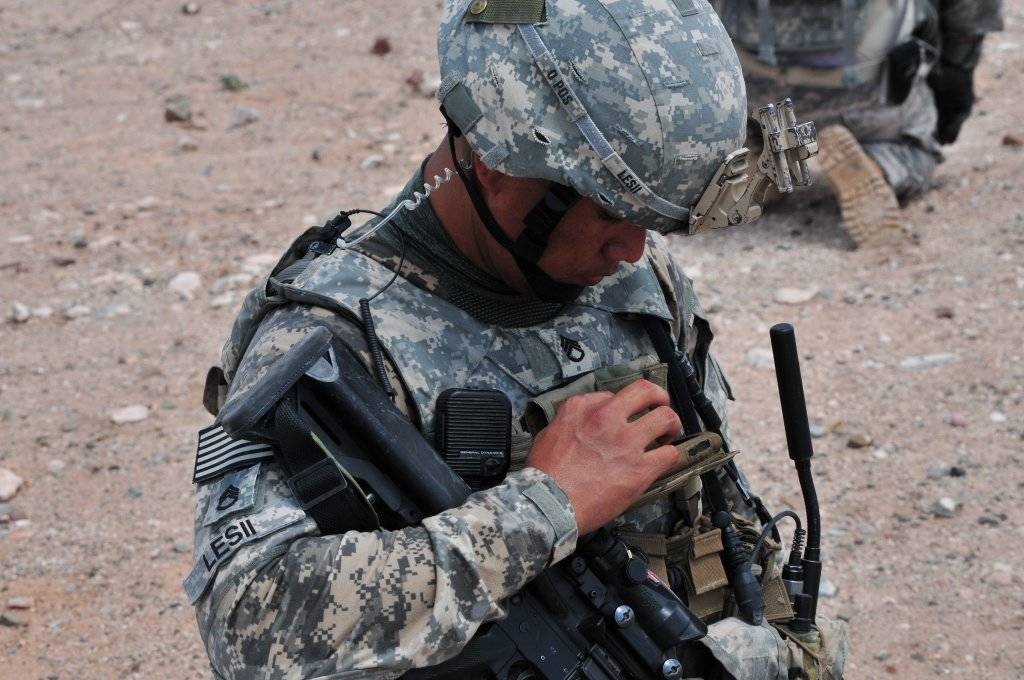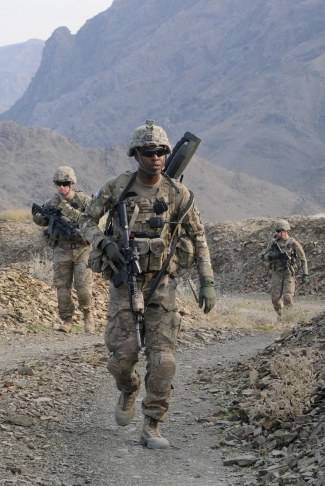
Secure smartphones and tablets for soldiers. Secure Wi-Fi for command posts. Digital assistants for Mission Command. Offensive and defensive cyber weapons. Sound like science fiction? Not for long. These innovations and others are on their way to reality as the Army takes its information network to the next level in support of Force 2025.
While network modernization has been an Army priority for several years, it has now taken on greater urgency. The Army of the future will deploy teams to austere environments at a moment’s notice with the ability to connect to the network and access information regardless of location.
U.S. forces will also need to dominate the invisible realm of cyberspace, where our adversaries grow more sophisticated every day. In addition, with network and cyber capabilities central to commanders’ mission planning and execution, the systems we deliver must pass the “smartphone test”: intuitive for all soldiers to learn and operate.
Digital Guardian Angel
The Army vision for Force 2025 is based on the imperative to retain overmatch against increasingly capable opponents in a persistently complex, unstable and dynamic security environment. In response, the Force 2025 campaign now underway aims to produce a globally responsive force that is leaner and smaller with greater combat power. Covering more ground with fewer boots requires more speed and versatility than we have today.
That is where the network comes in. The cliché that information is power is truer now than ever before. For a smaller force, information is success and survival. Just ask the 4th Brigade Combat Team, 10th Mountain Division (Light Infantry), which deployed to Afghanistan last summer. Reconfigured as a security force assistance brigade with less than half its soldiers, the unit regularly sent small security and advisory teams to dangerous areas with a history of attacks against coalition forces. They relied on the network (in the form of Rifleman Radios and smartphone-like Nett Warrior systems carried by individual soldiers) as a “digital guardian angel” that provided constant situational awareness of far flung troops’ locations and mission progress.
On a broader scale, the network provided U.S. and coalition forces a real-time picture of the 2014 Afghan presidential elections. As soldiers spread out to observation points near polling places, they plugged into mobile tactical network hotspots provided by vehicles integrated with Warfighter Information Network-Tactical Increment 2. They used email, chat and portal applications, and satellite phones to feed information into the common operating picture of the election and associated security activities, allowing leaders to adjust assets as needed.
Together, these scenarios illustrate how the Army can leverage a robust network to apply strategic landpower and achieve security and force protection goals in all mission settings. To build that network and achieve the speed and versatility that Force 2025 demands, the Army is pursuing several initiatives to address known capability gaps, mimic the simplicity and capacity of commercial networks, and provide commanders and soldiers the information they need to execute decisive actions anytime, anywhere, on any device.
Global Network

Demand for the network is extraordinary. Whether it’s the day-to-day business of running the Army, individual and unit training, or executing combat, humanitarian assistance or support operations, the network is completely integrated into everything the Army does. Shrinking end strength won’t lower that demand; rather, demand will grow, perhaps exponentially, as reliance on information and increasingly sophisticated technology increases and forward-deployed forces reach back more often for nonresident capability.
To accommodate these evolving needs, the Army will leverage industry advances in cloud and mobile technologies to support a global network that is an operational platform for all Army missions. The ability to access real time secure information at the point of need via an always on, actively defended, inherently secure and globally available network will change the way we fight.
To make the global network a reality, the network backbone throughput capacity is being upgraded more than tenfold and the individual installation capacity more than thirtyfold. In addition, standards are being codified to establish a foundation that is flexible and adaptable. With the new architecture, industry will know in advance how to build new technology that integrates with the existing infrastructure, putting capability into soldiers’ hands much more quickly.
These network advancements won’t matter, though, if the Army can’t protect the network and our information. Currently, the Army is focusing on centralizing security at the enterprise level. By reducing the number of security boundaries, our footprint shrinks dramatically, the attack surface diminishes and the cyber perimeter becomes much more defensible.
Greater capacity, more flexibility and tighter security are great things in and of themselves. Combined, they enable the soldier to make faster and better-informed decisions than ever before. Enterprise-level, cloud-based delivery of data, applications and information technology services makes access reliable, ubiquitous, trusted and straightforward regardless of time, place or circumstance. Soldiers and leaders will share a true, real-time common operating picture from the time they begin pre-deployment preparations until the time they complete the mission and arrive back home. The applications they use in garrison will be available in the area of operations, and the tactical systems they use in theater will be available at home station. Soldiers will finally be able to stay thoroughly current on their skill sets at all times and move seamlessly from one environment to another.
More User-Friendly
The Army is implementing a phased modernization plan for the tactical portion of the network as well. The blueprint will help focus industry and government development efforts and innovation. It will also help direct the Army’s limited modernization resources to the investments that will have the greatest short-, mid- and long term impact for the end user.
Leveraging lessons learned from Afghanistan and Iraq, the plan centers on adaptive, scalable network solutions that can be quickly adjusted based on mission, region, task organization and other factors. It converges and strengthens network operations tools to make communications systems easier to install, operate, maintain and defend, and it automates the network reconfiguration processes associated with task organization changes. It also helps address bandwidth and spectrum constraints through next-generation waveforms that dynamically adapt to austere environments that lack communications infrastructure. In addition, it calls for lightening network systems’ energy burden and exploiting wireless technology for quicker setup and teardown of command posts to support dynamic operations.
The road map’s other major priority is to make the network more user-friendly. Picture a soldier who owns multiple personal devices that run Apple, Google or Microsoft operating systems. While his or her smartphone may not have all the capabilities available on a desktop computer, the applications, widgets, icons and other features look and feel the same. The Army must do the same in the tactical realm by delivering standard maps, messaging and applications that are intuitive to operate and thereby reduce the training burden.
Ultimately, the Army must create a tactical computing environment that provides a unified user experience, from handheld devices to vehicle platforms to command posts. The Army is already working to incorporate more touch screens, voice and gesture recognition capabilities, and “Siri”-like digital assistants to enable commanders and soldiers to request, receive and act on information more quickly during operations—when time is of the essence.
For the dismounted soldier, the Army crossed a major communications threshold in 2013 with the software-defined Rifleman Radio, which connects with Nett Warrior handheld devices to transmit position location information, text messages, photos and other data. The next step is to “untether” the smartphone from the radio, using 4G/LTE wireless technology, so troops can communicate more easily across echelons. The Rifleman and other software- defined tactical radios will continue to improve as we maintain a competitive marketplace for commercial hardware, driving innovation among our industry partners while lowering costs for the Army.
It is clear that a globally responsive, regionally engaged Army requires an advanced, mission-tailorable network, especially as our adversaries continue to benefit from ever evolving and ever-cheaper commercial technologies. The power of information allows a smaller force to “be big,” and delivering that information in a user-friendly, flexible and seamless way is essential to achieving Force 2025 goals. Getting the network right may be the most important thing the Army does in the next five years. Mission accomplishment and the lives of our soldiers and unified action partners depend on it.
Lt. Gen. Robert S. Ferrell is the Army Chief Information Officer/ G-6, reporting directly to the Secretary of the Army, setting strategic direction and objectives for the Army network, and supervising all Army C4 (command, control, communications and computers) and information technology functions.
Lt. Gen. Michael E. Williamson is the principal military deputy to the Assistant Secretary of the Army for Acquisition, Logistics and Technology (ASA [ALT]) and director of Acquisition Career Management, overseeing the Army’s portfolio of acquisition programs as well as its acquisition workforce. His previous assignments included joint program executive officer for Joint Tactical Radio Systems, assistant deputy for acquisition and systems management, and deputy commanding general, Combined Security Transition Command-Afghanistan.
Maj. Gen. Daniel P. Hughes is the program executive officer (PEO) for Command, Control and Communications-Tactical, leading the Army’s acquisition, fielding and support of tactical network and Mission Command systems. His previous assignments included ASA (ALT) director of System of Systems Integration, deputy PEO Integration (Networks) and deputy PEO Enterprise Information Systems.
# # #



